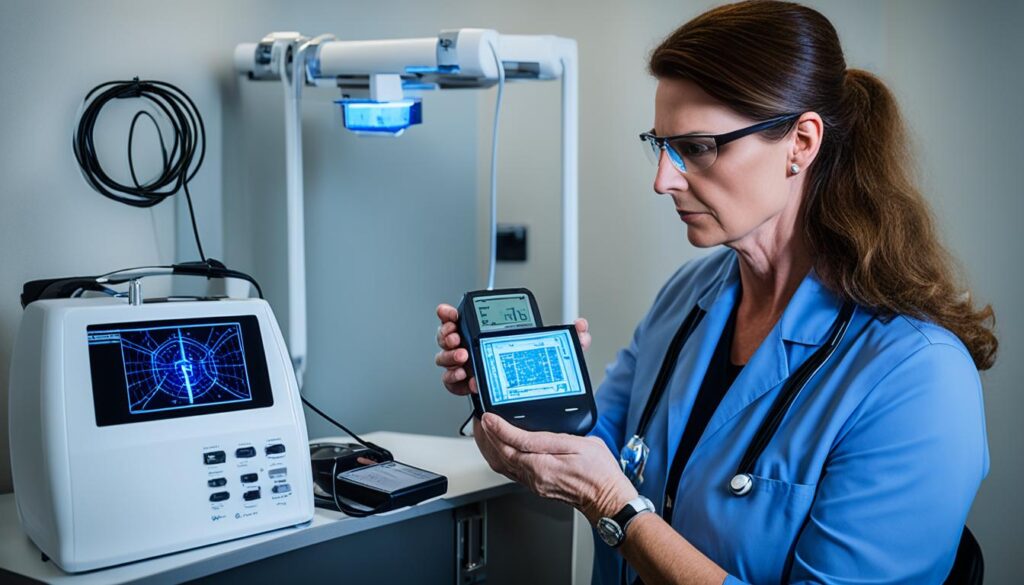Disclosure: This Post Contains Affiliate Links; We earn a commission on purchases.
In our hyper-connected world, the benefits of technology are undeniable. However, with the increasing use of electronic devices, concerns about electromagnetic field (EMF) exposure have also emerged. Mindful living in a digital world involves adopting practices that promote digital mindfulness and reduce the potential health risks associated with prolonged EMF exposure.
Digital mindfulness entails being conscious of our technology use and making intentional choices to safeguard our well-being. By implementing simple strategies, individuals can minimize EMF exposure and maintain a healthy balance between technology and personal wellness.
Here are some practical digital wellness tips and mindful technology usage strategies:
Key Takeaways:
- Embracing mindful living in a digital world can help reduce EMF exposure.
- Practicing digital mindfulness involves being intentional about technology use.
- Limiting device usage, keeping devices at a distance, and turning off Wi-Fi at night can minimize EMF emissions.
- Using wired connections, airplane mode, and EMF-reducing products can further reduce exposure.
- Grounding, leading a healthy lifestyle, and staying informed about EMF research are essential for personal well-being.
Understanding Electromagnetic Fields (EMFs)
Electromagnetic fields (EMFs) are invisible energy fields that emanate from electronic devices and power sources. They are an essential part of modern life, powering our devices and providing us with valuable communication and convenience. However, concerns have been raised about the cumulative effects of prolonged EMF exposure and their potential impact on our health.
EMFs are present in various forms, such as radio waves, magnetic fields, and electric fields. They exist wherever there is electricity flowing, and we are constantly surrounded by them, whether it’s from our smartphones, laptops, or even household appliances. The proliferation of wireless technologies has further increased our exposure to EMFs.
The cumulative effects of EMF exposure have become a subject of debate and research. While some studies suggest a possible link between long-term EMF exposure and adverse health effects, it is important to note that the scientific community has not reached a consensus on the matter. Nonetheless, it is prudent to be mindful of our exposure and take steps to minimize unnecessary risks.
To better understand the potential impact of EMFs on health, it is essential to consider the duration and intensity of exposure, as well as individual susceptibility. Factors such as proximity to EMF sources, duration of exposure, and personal sensitivity may all play a role in determining the potential health effects.
“The extent of the health risks associated with EMFs is still a topic of ongoing research and debate. While some studies suggest a possible link between long-term EMF exposure and health issues, more research is needed to establish conclusive evidence.”
It is worth noting that EMFs are classified as non-ionizing radiation, which means they do not have enough energy to remove electrons from atoms or molecules. Unlike ionizing radiation, such as X-rays or gamma rays, which can cause damage at the cellular level, non-ionizing radiation is generally considered to have lower risks.
Nonetheless, as technology continues to advance and our exposure to EMFs increases, it is vital to stay informed about the potential health effects and take proactive measures to minimize unnecessary exposure. This includes adopting practical strategies to reduce EMF emissions in our environments, as well as practicing digital mindfulness.
Reducing EMF Exposure
Limiting device usage is one of the most effective ways to reduce exposure to electromagnetic fields (EMFs). By setting boundaries for screen time and taking regular breaks, you can minimize your exposure and give your body a chance to recover.
Keeping devices at a distance when not in use is another simple yet impactful strategy. By placing your smartphone or tablet a few feet away from you, you can significantly reduce the amount of EMFs you are exposed to.
Turning off Wi-Fi at night is another crucial step in reducing EMF emissions. Not only does this lower your exposure while you sleep, but it also promotes better sleep quality and restfulness.
Using wired connections instead of relying solely on wireless connections can also help minimize exposure. By connecting your devices directly to the internet using an Ethernet cable, you can reduce your exposure to Wi-Fi signals.
Another practical tip is to use airplane mode when you don’t need to be connected. This feature turns off all wireless signals on your device, including cellular data and Wi-Fi, further reducing your EMF exposure.
Investing in EMF-reducing products is another option to consider. Phone cases or clothing designed to minimize exposure can provide an additional layer of protection against EMFs.
Creating EMF-free zones in specific areas of your home can also help reduce your overall exposure. Choose rooms where you spend the most time, such as the bedroom or living room, and make them EMF-free by minimizing the use of electronic devices and keeping them away from these areas.
Remember, every small step you take to minimize your exposure to EMFs can have a positive impact on your overall well-being.

Personal Well-Being Practices
When it comes to living in a digital world, incorporating personal well-being practices can help individuals maintain a healthy balance between technology and mindfulness. By being mindful of screen time, practicing grounding, adopting a healthy lifestyle, and staying informed about EMF awareness, individuals can proactively manage their well-being in a digital age.
Mindful Screen Time
It’s important to be mindful of the time spent in front of screens and how it can impact our overall well-being. Constant exposure to screens can lead to eye strain, disrupted sleep patterns, and decreased productivity. By setting boundaries, taking regular breaks, and being intentional about screen usage, individuals can ensure they maintain a healthy relationship with technology.
Grounding for Balance
Grounding, or making direct physical contact with the Earth’s surface, is believed to have numerous benefits for our well-being. Spending time outdoors, walking barefoot on grass, or immersing ourselves in nature allows us to connect with the Earth’s energy and restore balance. It’s a simple practice that can help reduce stress, improve sleep, and enhance overall vitality.
Embrace a Healthy Lifestyle
A healthy lifestyle is the foundation for resilience against various environmental stressors, including the potential impact of EMFs. By focusing on a balanced diet, regular exercise, and sufficient sleep, individuals can strengthen their body’s ability to cope with the challenges posed by the digital world. Additionally, prioritizing self-care, stress management, and maintaining healthy relationships further contributes to a holistic and thriving life.
Stay Informed about EMF Awareness
As research on EMFs continues to evolve, staying informed about the latest findings and health recommendations is crucial. Being aware of the potential risks associated with prolonged EMF exposure allows individuals to make informed choices about their environment and device usage. It’s advisable to follow reputable sources, consult experts, and consider EMF-reducing technologies or practices for added peace of mind.
By practicing mindful screen time, incorporating grounding techniques, embracing a healthy lifestyle, and staying informed about EMF awareness, individuals can optimize their digital experience while prioritizing their overall well-being in a rapidly evolving digital landscape.
Seek Professional Advice
If you have significant concerns about EMF exposure and its potential impact on your health, it is advisable to consult with a healthcare professional or environmental consultant. These experts have the knowledge and expertise to provide personalized advice and assess your living and working environments for potential EMF sources.
When it comes to EMF exposure, seeking professional advice can help you better understand the risks and take appropriate measures to protect your well-being. A healthcare professional, such as a doctor or naturopath, can evaluate your symptoms and provide guidance on managing EMF exposure. They may also recommend specific tests or treatments to address any health issues related to EMFs.
“It’s important to consult with a healthcare professional if you’re worried about EMF exposure. They can provide valuable insights and help you make informed decisions about protecting your health.”
An environmental consultant specializes in assessing environmental factors, including EMF exposure. They can conduct thorough inspections of your home or workplace, identifying potential EMF sources and recommending strategies to reduce exposure. Their expertise can help create an EMF-safe environment tailored to your specific needs and concerns.
Working with healthcare professionals and environmental consultants can provide you with peace of mind and empower you to make informed decisions about managing EMF exposure. Remember, your health and well-being should always be a priority.
Case Study: The Role of a Healthcare Professional
Let’s take a look at a real-life example to understand how consulting a healthcare professional can make a difference in managing EMF exposure.
| Case Study: John’s EMF Concerns |
|---|
 |
| Situation: John has been experiencing frequent headaches and difficulty concentrating. He suspects that EMF exposure from his electronic devices and Wi-Fi router may be the cause. |
| Consultation: John makes an appointment with a healthcare professional who specializes in environmental health. During the consultation, John explains his symptoms and concerns about EMF exposure. |
| Evaluation: The healthcare professional conducts a thorough assessment of John’s symptoms, medical history, and living environment. They discuss the potential health effects of EMF exposure and the importance of reducing exposure levels. |
| Recommendations: Based on the evaluation, the healthcare professional recommends specific strategies for reducing EMF exposure, such as setting boundaries for screen time, using airplane mode, and creating an EMF-free sleeping area. They also suggest incorporating mindfulness practices and implementing grounding techniques. |
| Results: With the guidance of the healthcare professional, John implements the recommended strategies to reduce his EMF exposure. Over time, his headaches decrease in frequency, and he notices improvements in his ability to focus and concentrate. |
Conclusion
In our digital age, where technology is an inherent part of our daily lives, it is crucial to manage electromagnetic fields (EMFs) wisely to safeguard our well-being. By adopting mindful practices, reducing unnecessary exposure, and seeking professional advice when needed, individuals can strike a balance between staying connected and promoting personal wellness in a digital world.
EMF management begins with informed choices. Mindful practices, such as setting boundaries for screen time and taking regular breaks, can help reduce EMF exposure. Additionally, keeping electronic devices at a distance when not in use, turning off Wi-Fi at night, and using wired connections can minimize EMF emissions in our immediate environment. Investing in EMF-reducing products, such as phone cases or clothing, and creating EMF-free zones at home further contribute to managing EMFs effectively.
However, it is essential to recognize that each individual’s sensitivity to EMFs may vary. Seeking professional advice from healthcare professionals or environmental consultants can provide personalized guidance and assessments of living and working environments. Their expertise can help individuals make informed decisions about managing EMF exposure and optimizing their well-being in the digital age.
Remember, a mindful approach and moderation are key. By staying informed, adopting healthy practices, and taking proactive steps to manage EMFs, we can prioritize our wellness while enjoying the benefits of a connected world.
Source Links
- https://www.linkedin.com/pulse/navigating-digital-age-managing-electromagnetic-fields-oko-choi
- https://techwellness.com/
- https://techwellness.com/blogs/expertise/10-best-emf-protection-top-tips-free

Subscribe to Our Newsletter










